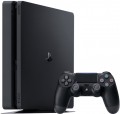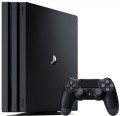Features
—
DVD/Blu-ray drive. Drive for reading optical discs. This feature is typical mainly for desktop set-top boxes (see "Form factor"); they at least support DVD, but many models are capable of working with Blu-ray. However, there are also portable consoles that support optical discs — full-size DVD / Blu-ray are too bulky for them, so specific formats are usually used in such cases (such as UMD in some PlayStation Portable models). Discs are most often used as media for games, although some models may also provide the ability to play audio and video (that is, in fact, use the set-top box as a media centre).
—
HDR support. The ability to output a desktop video signal with the so-called extended dynamic range. In such an image, firstly, the colour depth increases (in other words, more different shades are displayed), and secondly, the contrast is enhanced — light areas look brighter, and dark areas look darker. This improves colour quality, makes the image more realistic and enhances the impression of depth, the picture is perceived as less flat. However you need to keep in mind that to fully use this function, you will also need a TV or other HDR-enabled screen — otherwise, all the advantages of this technology will be nullified by the limitations in the functionality of the screen itself. Also note that HDR technology has several formats (for example, HDR10 and HDR Dolby Vision), and not all of them ar
...e compatible with each other. Therefore, to use this feature, you should make sure that the set-top box and TV are compatible with HDR standards.
— UltraHD (4K) support. The ability to work set-top box with the image standard 4K. The standard resolution of such an image is 3840x2160, which is 4 times higher than Full HD in terms of the number of pixels. This feature is mainly found in set-top boxes and allows you to output 4K video to a TV or other external device. Thus, you can get a very high quality, detailed image. However, note that in order to fully view such an image, it must be supported not only by the console, but also by the screen to which it is connected — otherwise all the advantages of ultra-high resolution will be nullified. Also note that not all modern games and other content are available in 4K (although, of course, nothing prevents you from playing videos of lower resolutions on the set-top box).
— Support for video services. Ability to work set-top boxes with various network video services. Usually, pre-installed client programs are responsible for this function, which makes it easy to search and play various content on the Internet. Among the video services supported by modern set-top boxes, there are, in particular, YouTube (the most famous and largest network video site), Netflix (one of the largest producers of TV series distributed over the Internet), Amazon Video (provider of TV series and films on demand) and others. . Note that access to content may be paid and have regional restrictions.USB 3.2 gen1
The number of full-size
USB 3.2 gen1(formerly USB 3.1 gen1 and USB 3.0) ports in the set-top box.
This standard differs from the USB 2.0 described above by an increased maximum data transfer rate of up to 4.8 Gbps, as well as a greater power supplied to the power connector; otherwise, both versions are almost identical and fully compatible with each other.
Additional
Additional connectors provided in the design of the set-top box in addition to those described above. A set of such connectors may include, in particular:
— Proprietary ports for wired gamepads and other controllers.
— IR (IR) inputs and outputs to work with various wireless accessories.
— Digital audio outputs for multi-channel audio. The most popular standard for such outputs is S / P-DIF, it has two varieties — optical and coaxial. The optical output can be separate or combined with the Mini-Jack 3.5 mm output (see "Connectors"); its advantage is the insensitivity of the cable to electrical interference, but the cable itself is quite fragile and requires delicate handling. Coaxial (electrical) connections are not as sensitive, but are more prone to interference.
— Analogue audio and video outputs (AUX, composite, component) — these connectors can be useful for connecting outdated video equipment.
Graphics card performance
The performance of the graphics card installed in the game console.
Performance is measured in FLOPS, the number of floating point math operations that a graphics card processor can perform in one second. Game consoles traditionally use teraflops, or trillions of operations per second.
Theoretically, higher performance means a more advanced graphics card and corresponding graphics quality. However, in fact, this parameter is often given more for promotional purposes than to describe the actual capabilities of the console. The fact is that the quality of game graphics depends not only on the capabilities of the graphics card, but also on other factors — including the general characteristics of the set-top box (processor, memory, etc.), as well as how well the games are optimized for this platform . Therefore, models similar to each other in this indicator may differ markedly in the actual video capabilities. Moreover, a relatively modest graphics card can also outperform a more performant counterpart. For example, Microsoft's Xbox One S, which has a "only" 1.4 TFLOPS video accelerator, supports 4K resolution and HDR (see "Features"), while its peer PS 4 Slim with a 1.84 TFLOPS graphics card TFLOPS does not have such capabilities. Therefore, it makes sense to compare video performance only on consoles that differ significantly in digital indicators.
Internal storage
The volume of the set-top box's own built-in storage (see "Storage"). The larger this volume, the more information can fit directly in the device, the less often you have to clean the storage. It is worth noting that the same model of a desktop set-top box can be produced with different volumes (
500 GB,
1 TB and
2 TB). For portable set-top boxes, much less volume is available — up to
250 GB
